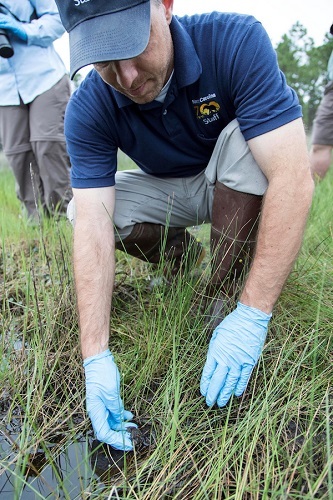North Carolina Zoo Strives to Save Carolina Gopher Frog
Posted on 08/27/19 Carolina gopher frog release in the Sandhills - Photo Credit: Brady Beck/N.C. Zoo
Carolina gopher frog release in the Sandhills - Photo Credit: Brady Beck/N.C. Zoo
ASHEBORO, N.C. – The North Carolina Zoo just completed its fourth successful season of “head-starting” an army (or group) of one of North Carolina’s rarest amphibians, the Carolina gopher frogs in partnership with the North Carolina Wildlife Resource Commission (NCWRC).
“We recently released around 325 Carolina gopher froglets, which brings our total number of froglets released into the wild since 2016 to nearly 800,” said Curator of Herpetology Dustin Smith at the North Carolina Zoo.
The rare and secretive Carolina gopher frog resembles a toad and lives primarily in long-leaf pine savannas of the Sandhills area of North Carolina. The frogs have now been listed as endangered by the NCWRC, as populations have dwindled from 30 habitats to only six in the state.
The North Carolina Zoo has been “head-starting” the frogs to grow their populations in the wild. Zoo staff has been collecting Carolina gopher frog eggs from the wild to the “tadpole nursery” at the North Carolina Zoo, where they are given a “head start,” safe from predators, habitat degradation, and environmental factors. After a few months, the tadpoles become froglets and are returned to the ponds where they were found.
We have had many successes and failures in the four years that we have been head-starting Carolina gopher frogs – namely combatting non-native fire ants,” said the Zoo’s Animal Management Supervisor Chris Shupp, who has led the Zoo’s efforts in the program.
Some of the frogs released to the wild are wearing transmitters and are being closely monitored to learn more about their movements and habitat needs. The radio-tracking has provided valuable information about the Carolina gopher frog movements and refuge sites, as well as additional threats and more.
Frogs can be an important indicator species, serving as a measure of environmental conditions, because they live in two environments – both land and water. And frogs have thin skin and can absorb toxic chemicals, radiation, bad bacteria, and diseases. Frogs also play an important role in the food chain as they are both predator and prey. When frogs disappear from an environment, then many other animals and insects are impacted. If an area has strong amphibian diversity, then it means there is a healthy ecosystem.
The public can view rare Carolina gopher frogs in the Sandhills section of the Zoo’s Cypress Swamp habitat.
Your visit to the North Carolina Zoo helps save the Carolina gopher frogs and supports other frog conservation programs in the wild.
UNC-TV will be featuring the North Carolina Zoo’s efforts to save the Carolina gopher frog in an upcoming segment airing in September 2019. Their television crews came along with Zoo staff to the North Carolina wetlands for a froglet release this summer and recorded the weighing, tagging, and release of an army of Carolina gopher frogs.
About the North Carolina Zoo
At the North Carolina Zoo, we celebrate nature. As the world’s largest natural habitat Zoo, we inspire a lifelong curiosity about animals for the hundreds of thousands of people who visit our Zoo each year. Our dedicated team of experts provides exceptional, compassionate care for the more than 1,800 animals and 52,000 plants that call our Park home. We also lead efforts locally and globally to protect wildlife and wild places because we believe nature’s diversity is critical for our collective future. The North Carolina Zoo invites all of our guests to witness the majesty of the wild in the heart of North Carolina and welcomes everyone to join in our mission to protect nature’s diversity. Visit NCZoo.org to begin your life-changing journey.
About the N.C. Department of Natural and Cultural Resources
The N.C. Department of Natural and Cultural Resources (NCDNCR) is the state agency with a vision to be the leader in using the state’s natural and cultural resources to build the social, cultural, educational and economic future of North Carolina. NCDNCR’s mission is to improve the quality of life in our state by creating opportunities to experience excellence in the arts, history, libraries and nature in North Carolina by stimulating learning, inspiring creativity, preserving the state’s history, conserving the state’s natural heritage, encouraging recreation and cultural tourism, and promoting economic development.
NCDNCR includes 27 historic sites, seven history museums, two art museums, two science museums, three aquariums, and Jennette’s Pier, 39 state parks and recreation areas, the North Carolina Zoo, the nation‘s first state-supported Symphony Orchestra, the State Library, the State Archives, N.C. Arts Council, State Preservation Office and the Office of State Archaeology, along with the Division of Land and Water Stewardship. For more information, please call 919- 807-7300 or visit www.ncdcr.gov.
# # #






